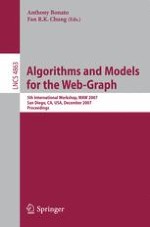2007 | Buch
Algorithms and Models for the Web-Graph
5th International Workshop, WAW 2007, San Diego, CA, USA, December 11-12, 2007. Proceedings
herausgegeben von: Anthony Bonato, Fan R. K. Chung
Verlag: Springer Berlin Heidelberg
Buchreihe : Lecture Notes in Computer Science

